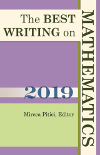- About MAA
- Membership
- MAA Publications
- Periodicals
- Blogs
- MAA Book Series
- MAA Press (an imprint of the AMS)
- MAA Notes
- MAA Reviews
- Mathematical Communication
- Information for Libraries
- Author Resources
- Advertise with MAA
- Meetings
- Competitions
- Programs
- Communities
- MAA Sections
- SIGMAA
- MAA Connect
- Students
- MAA Awards
- Awards Booklets
- Writing Awards
- Teaching Awards
- Service Awards
- Research Awards
- Lecture Awards
- Putnam Competition Individual and Team Winners
- D. E. Shaw Group AMC 8 Awards & Certificates
- Maryam Mirzakhani AMC 10 A Awards & Certificates
- Two Sigma AMC 10 B Awards & Certificates
- Jane Street AMC 12 A Awards & Certificates
- Akamai AMC 12 B Awards & Certificates
- High School Teachers
- News
You are here
The Best Writing on Mathematics 2019

Publisher:
Princeton University Press
Publication Date:
2019
Number of Pages:
304
Format:
Paperback
Price:
24.95
ISBN:
9780691198354
Category:
Anthology
The Basic Library List Committee suggests that undergraduate mathematics libraries consider this book for acquisition.
[Reviewed by , on ]
Tom French
12/8/2019
Editor Mircea Pitici has done an outstanding job in presenting the 10th edition of The Best Writing on Mathematics …. series. The 2019 edition of this series is a collection of writings from around the world that were originally published in a variety of mathematics and scientific journals. The book includes publications for both the specialist as well as the general reader. However, the readings are accessible to all and can be appreciated by both.
The 18 articles selected for this edition cover a wide range of topics. The themes include varied mathematical subjects that one would expect to find in college or high school courses. I won’t enumerate all the presentations in this volume, however, I’ll mention a few to give you an idea of the depth and range of studies provided in this volume: Fair Division, Geometry, History & Philosophy of Mathematics, Probability, Statistics, and The Field’s Medal.
The Best Writing on Mathematics 2019 provides a rich resource for both the college professor and the high school (or middle school) teacher who is on the lookout for practical applications of mathematics or science. These articles demonstrate that mathematics is an ever-growing discipline with almost unlimited applications.
Each of the articles covers topics from mathematics or physics. I found myself totally enchanted reading how the “Markov Chain Monte Carlo Method” or “The Ham Sandwich Problem” proposed by Polish mathematicians in the 1930’s could provide our US Courts with a remedy for how to measure gerrymandering. Another article discusses the question, “Does Mathematics Teach How to Think?”. I enjoyed the geometric relationship called mirror symmetry discovered by string theorists who detected an astounding relationship between two very different geometric worlds.
The majority of articles in this collection are less than 20 pages and can easily be read in one sitting. The articles are not written in a particular chronological order, so one may skip around when reading this book. For example, glancing through the Table of Contents, a reader may decide to begin with the 16th article which is “Ethics in Statistical Practice and Communications: Five Recommendations,” and then read an earlier selection. Since each article is a stand-alone, nothing is sacrificed by not reading the book chronologically.
Editor Pitici also provides us a list of over 200 ‘notable writings’ from the year that did not make the cut and appear in this volume. Her list provides us the name of the author, source and date of the publication, as well as the page numbers. This book will become a welcome addition to my library and has me wondering what I missed in the earlier editions.
Tom French (tfrench166@charter.net) has a B.S. and M.S. degree in Mathematics from Minnesota State University, Mankato. He has 35 years of engineering and business experience with UNIVAC and its successor companies. He has lectured on mathematics and computer systems throughout the world and has taught mathematics at a number of US colleges and universities.
Introduction
Geometry v. Gerrymandering
Slicing Sandwiches, States, and Solar Systems: Can Mathematical Tools Help Determine What Divisions Are Provably Fair?
Does Mathematics Teach How to Think?
Abstracting the Rubik’s Cube
Topology-Disturbing Objects: A New Class of 3D Optical Illusion
Mathematicians Explore Mirror Link between Two Geometric Worlds
Professor Engel’s Marvelously Improbable Machines
The On-Line Encyclopedia of Integer Sequences
Mathematics for Big Data
The Un(solv)able Problem
The Mechanization of Mathematics
Mathematics as an Empirical Phenomenon, Subject to Modeling
Does 2 ˖ 3 = 5? In Defense of a Near Absurdity
Gregory’s Sixth Operation
Kolmogorov Complexity and Our Search for Meaning: What Math Can Teach Us about Finding Order in Our Chaotic Lives
Ethics in Statistical Practice and Communication: Five Recommendations
The Fields Medal Should Return to Its Roots
The Erdős Paradox
Contributors
Notable Writings
Acknowledgments
Credits
- Log in to post comments




